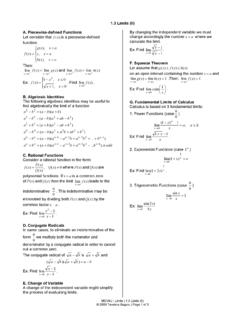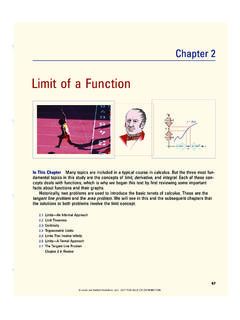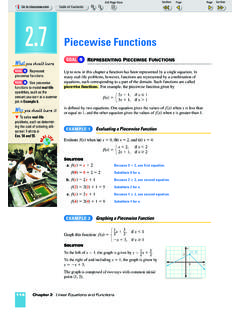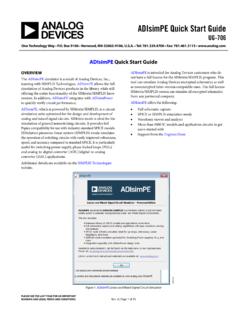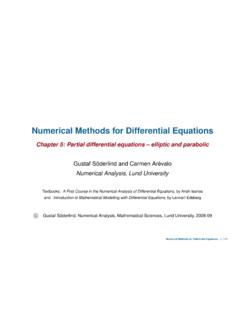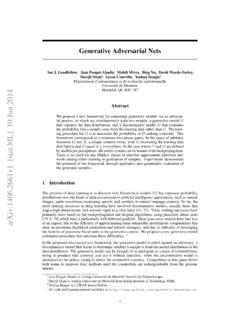Transcription of Branch-and-bound methods for an MINLP model …
1 Branch-and-bound methods FOR AN MINLP MODELWITH SEMI-CONTINUOUS VARIABLESERWIN document describes several Branch-and-bound methods tosolve a convex Mixed-Integer Nonlinear Programming ( MINLP ) problem withGAMS. A straightforward MINLP formulation is compared with a piecewiselinear approximation. In addition we include a Branch-and-bound algorithmimplemented following question was posed:Does anybody know an algorithm or mathematical description to solvethe following sum(i=1 to n) c_i +(d_i-c_i)/(1+exp(-(x_i-a_i)/b_i)) (=the sum of n logistic functions), with a_i < 0 and b_i > 0 and c_i < (i=1 to n) x_i <= BudgetWhen x_i >0 then x_i>= Budget_{min}I know that I can describe the last restriction asx_i <= M*y_ix_i >= Budget_{min}*y_iwith y_i binary, but I don t want to use binary would be best to have only linear anybody know another way to solve this problem. Perhaps a simplealgorithm is enough to find the optimal solution because all nlogistic functions are convex for x_i >=0 (because a_i < 0)The mathematical model looks like:max ici+di ci1 + exp( xi aibi) ixi Bxi {0} [L, )(1)Indeed the functions(2)fi(x) =ci+di ci1 + exp( x aibi)are convex, as can be seen from the figure , the non-convexity introduced byxbeing not a continuous variable willcause that this model can not be solved using an NLP solver : April, KALVELAGENF igure formulationThe simplest approach is to use an MINLP solver directly.]
2 The variablesxiareof a special type called semi-continuous. A semi-continuous variablexis eitherzero or between its bounds [L,U]. This type of variable is often used to preventvery small values. in portfolio models, this restriction is sometimes added toprevent a lot of very small holdings which cause extra management and transactioncosts and are thus variables can be implemented in GAMS using the semicontvariable type:semicont variables x;The complete model looks like:set i /i1*i10/;parametersa(i) <0 b(i) >0 c(i) c(i) < d(i) d(i);a(i) = -ord(i);b(i) = ord(i);c(i) = ord(i);d(i) = c(i)+ord(i);display a,b,c,d;scalarBRANCH-AND- bound methods FOR AN MINLP model WITH SEMI-CONTINUOUS VARIABLES3budget_avail / 10 /minx / ;*-------------------------------------- -----------------------* MINLP model with semi-continuous variables*------------------------------ -------------------------------variables x1(i)z1;semicont variable x1;equationslogistic1budget1; z1 =e= sum(i, c(i) +(d(i)-c(i))/(1+exp(-(x1(i)-a(i))/b(i))) ); sum(i, x1(i)) =l= budget_avail; (i) = minx; model m1 /logistic1,budget1/option MINLP =sbb.
3 Option optcr=0;solve m1 maximizing z1 using MINLP ;Semi-continuous variables can be easily converted to a formulation with binaryvariables. This can be important if the solver does not support semi-continuousvariables. The reformulation looks like:x Uyx Lyx [0,U]y {0,1}(3)It is needed that a tight upper boundUonxis available. In our case we know that ixi Band thusxi B.*------------------------------------- ------------------------* MINLP model with binary variables*------------------------------ -------------------------------variables x2(i)y2(i)z2;binary variable y2;positive variable x2;equationslogistic2budget2bigm2a(i)big m2b(i);scalar bigM;bigM = budget_avail; z2 =e= sum(i, c(i) +(d(i)-c(i))/(1+exp(-(x2(i)-a(i))/b(i))) ); sum(i, x2(i)) =l= budget_avail;bigm2a(i).. x2(i) =l= bigM*y2(i);bigm2b(i).. x2(i) =g= minx*y2(i);4 ERWIN KALVELAGEN model m2 /logistic2,budget2, bigm2a, bigm2b/option MINLP =sbb;option optcr=0;solve m2 maximizing z2 using MINLP ;The convexity will assure that the subproblems of the branch -and-solver SBB[3]can be solved to optimality, and thus that we find a global optimum linear approximationThe above model can be tackled by a MIP solver using a piecewise linear formu-lation.
4 As the objective function is a separable function, :(4)max ifi(xi)we can use a standard interpolation scheme using so-called SOS2 variables (specialordered sets of type two).Suppose we have tabular data for a scalar functiony=f(x) for a given intervalx [xlo,xup]. Let s denote this data by ( xk, yk). We introduce variables kwith:X= k k xk(5)Y= k k yk(6) k k= 1(7)max 2 adjacent s nonzero(8) k 0(9)xlo X xup(10)Equation (5) is called thereference row. Equation (6) is known as thefunction row,and equation (7) is theconvexity kvariables form a Special Order Set of Type 2. In a SOS2 set only twoadjacent variables of the set can assume non-zero variables can be implemented in GAMS using the SOS2 variable type:sos2 variables lambda(k);The exact definition of SOS2 variables is solver specific, especially in special caseswhere nonzero lower bounds are used. In the above case we have added k 0,which only leaves the max two adjacent s are nonzero which is shared by allsolvers that have SOS2 facilities.
5 *--------------------------------------- ----------------------* MIP model with piecewise linear objective using SOS2 variables*------------------------------ -------------------------------** set up grid (simply equidistant, but with logistic function* it would be better to use wider grid for larger x)*set k /k0*k200/;scalar stepsize;stepsize = budget_avail/(card(k)-1);parameter xbar(i,k), ybar(i,k);xbar(i,k) = (ord(k)-1)*stepsize;ybar(i,k) = c(i) +(d(i)-c(i))/(1+exp(-(xbar(i,k)-a(i))/b( i))); Branch-and-bound methods FOR AN MINLP model WITH SEMI-CONTINUOUS VARIABLES5 OOy//x yk 1 xk 1 yk xk yk+1 xk+1 yk+2 xk+2 444444444444444oooooooooFigure interpolationsos2 variables lambda3(i,k);semicont variables x3(i);variables z3,y3(i); (i) = minx; (i) = budget_avail;equationsrefrow3(i)funcrow3 (i)convexity3(i)budget3obj3;refrow3(i).. x3(i) =e= sum(k, lambda3(i,k)*xbar(i,k));funcrow3(i).. y3(i) =e= sum(k, lambda3(i,k)*ybar(i,k));convexity3(i).
6 Sum(k,lambda3(i,k)) =e= 1; sum(i, x3(i)) =l= budget_avail; z3 =e= sum(i, y3(i)); model m3 /refrow3, funcrow3, convexity3, budget3, obj3/option mip=cplex;option optcr=0;solve m3 maximizing z3 using mip;It is noted that we have set up an equidistant grid. In this case the logisticsfunction is the most non-linear at the beginning while it is almost linear forlarger values ofx. It could be beneficial to exploit this property, and space out thegrid more for larger values KALVELAGENAs we deal with a convex objective, we can actually drop the SOS2 variablesand consider them to be continuous:*---------------------------- ---------------------------------* MIP model with piecewise linear objective exploiting convexity* SOS2 variables can be relaxed to positive variables.*----------------------------- --------------------------------positive variables lambda4(i,k);semicont variables x4(i);variables z4,y4(i); (i) = minx; (i) = budget_avail;equationsrefrow4(i)funcrow4 (i)convexity4(i)budget4obj4;refrow4(i).
7 X4(i) =e= sum(k, lambda4(i,k)*xbar(i,k));funcrow4(i).. y4(i) =e= sum(k, lambda4(i,k)*ybar(i,k));convexity4(i).. sum(k,lambda4(i,k)) =e= 1; sum(i, x4(i)) =l= budget_avail; z4 =e= sum(i, y4(i)); model m4 /refrow4, funcrow4, convexity4, budget4, obj4/option mip=cplex;option optcr=0;solve m4 maximizing z4 using mip; nonlinear Branch-and-bound algorithmTheGAMS language is powerful enough to implement reasonable complex al-gorithms. Examples include Lagrangian Relaxation with subgradient optimization[7], Benders Decomposition [5] and Column Generation algorithms [6].In this section we implement a Branch-and-bound algorithm for the above standard Branch-and-bound algorithm for MINLP problems with integer vari-ables can look like [2]:{Initialization}LB:= UB:= Store root node in waiting node listwhilewaiting node list is not emptydo{Node selection}Choose a node from the waiting node listRemove it from the waiting node listSolve subproblemifinfeasiblethenNode is fathomedelse ifoptimalthenifinteger solutionthenifobj > LBthen{Better integer solution found}LB:=objBRANCH-AND- bound methods FOR AN MINLP model WITH SEMI-CONTINUOUS VARIABLES7 Remove nodesjfrom list withUBj< LBend ifelse{Variable selection}Find variablexkwith factional valuevCreate nodejnewwith boundxk bvcUBjnew:=objStore nodejnewin waiting node listCreate nodejnewwith boundxk dveUBjnew:=objStore nodejnewin waiting node listend ifelseStop.
8 Problem in solving subproblemend ifUB= maxjUBjend whileThe root node is the problem with the integer restrictions relaxed. For moredetails consult [1, 4, 8].When dealing with semi-continuous variables, we need to change just a fewthings. A variablexkis considered fractional if 0< xk< xlok. Secondly the boundswe add to the newly created nodes arexk 0 andxk xlok.*-------------------------------------------------------------* simple branch and bound algorithm*-------------------------------------------------------------variablesx5(i)z5;positive variable x5;equationslogistic5budget5; z5 =e= sum(i, c(i) +(d(i)-c(i))/(1+exp(-(x5(i)-a(i))/b(i)))); sum(i, x5(i)) =l= budget_avail; model m5 /logistic5,budget5/option nlp=conopt;*---------------------------------------------------------* datastructure for node pool* each node has variables x(i) which is either* still free, or fixed to zero or with a lowerbound* of minx.*---------------------------------------------------------set node maximum size of the node pool /node1*node1000/;parameter bound (node) node n will have an obj <= bound (n) ;set fixed(node,i) variables x(i) are fixed to zero in this node ;set lowerbound(node,i) variables x(i)>=minx in this node ;scalar bestfound lowerbound in B&B tree /-INF/;scalar bestpossible upperbound in B&B tree /+INF/;set newnode(node) new node (singleton) ;set waiting(node) waiting node list ;set current(node) current node (singleton except exceptions) ;8 ERWIN KALVELAGEN parameter log(node,*) logging information ;scalar done terminate /0/;scalar first controller for loop ;scalar first2 controller for loop ;scalar obj objective of subproblem ;scalar maxx;set w(node);parameter nodenumber(node);nodenumber(node) = ord(node).
9 Fixed(node,i) = no;lowerbound(node,i) = no;set j(i);alias (n,node);** add root node to the waiting node list*waiting( node1 ) = yes;current( node1 ) = yes;newnode( node1 ) = yes; bound ( node1 ) =INF;loop(node$(not done),** node selection*bestpossible = smax(waiting(n), bound (n));current(n) = no;current(waiting(n))$( bound (n) = bestpossible) = yes;first = 1;** only consider first in set current*loop(current$first,first = 0;log(node, node ) = nodenumber(current);log(node, ub ) = bestpossible;** remove current node from waiting list*waiting(current) = no;** clear bounds* (i) = 0; (i) = budget_avail;** set appropriate bounds*j(i) = lowerbound(current,i); (j) = minx;j(i) = fixed(current,i); (j) = 0;** solve subproblem*solve m5 maximizing z5 using nlp; Branch-and-bound methods FOR AN MINLP model WITH SEMI-CONTINUOUS VARIABLES9** check for optimal solution*log(node, solvestat ) = ;log(node, modelstat ) = ;abort$( <> 1) "Solver did not return ok";if ( = 1 or = 2,** get objective*obj = ;log(node, obj ) = obj;** check "integrality"*maxx = smax(i, min( (i), max( (i),0)));if (maxx = 0,** found a new "integer" solution*log(node, integer ) = 1;if (obj > bestfound,** improved the best found solution*log(node, best ) = 1;bestfound = obj;** remove all waiting nodes with bound < bestfound*w(n) = no; w(waiting) = yes;waiting(w)$( bound (w) < bestfound) = no;);else** "fractional" solution*j(i) = no;j(i)$(min( (i), max( (i),0))=maxx) = yes;first2 = 1;loop(j$first2,first2 = 0;** create 2 new nodes*newnode(n) = newnode(n-1);fixed(newnode,i) = fixed(current,i);lowerbound(newnode,i) = lowerbound(newnode,i); bound (newnode) = obj;waiting(newnode) = yes;fixed(newnode,j) = yes;newnode(n) = newnode(n-1);fixed(newnode,i) = fixed(current,i);lowerbound(newnode,i) = lowerbound(newnode,i); bound (newnode) = obj;waiting(newnode) = yes.)))))
10 10 ERWIN KALVELAGEN lowerbound(newnode,j) = yes;););else** if subproblem as infeasible this node is fathomed.* otherwise it is an error.*abort$( <> 4 and <> 5) "Solver did not solve subproblem";);log(node, waiting ) = card(waiting););** are there new waiting nodes?*done$(card(waiting) = 0) = 1;** display log*display log;);The log of this algorithm show it finds an optimal solution very quickly:---- 379 PARAMETER log logging informationnode ub solvestat modelstat obj integer best waitingnode1 +INF complete model can be downloaded Borchers and J. E. Mitchell,An improved branch and bound algorithm for mixed integernonlinear programming, Computers and Operations Research21(1994), 359 Borchers,( MINLP ) branch and bound methods , Encyclopedia of Optimization, vol.

